How to Choose the Right & Best Morse Key or Paddle
Selecting the right Morse key or Morse paddle for your needs can be difficult - check out our comprehensive guide to help you buy the best one for your needs.
Morse Code includes:
What is Morse code
How to learn Morse code
Morse code table / chart
Morse code keys & keyers
How to choose the best Morse key
How to use & set-up straight Morse key
How to use & set-up mechanical bug key
CW QSO
There is a huge selection of Morse keys, keyers and paddles available to buy, and trying to select the right one can be very difficult.
There is a wide selection of Morse keys varying widely in price - some may appear to be very costly when compared to many of the cheap gods we can buy in everyday life.
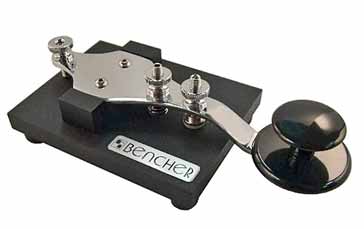
In view of the investment involved it is really important to make sure that the right key is bought and it is one that will suit your needs for many years to come.
Keys range from small plastic ones, right up to all metal ones, some even with marble bases to give them stability on the table - the costs also reflect the quality and effort in making them, as many are relatively labour intensive and are made in relatively small quantities these days.
First thoughts
Before looking at the keys themselves, it is worth thinking about the type of usage that it will get.
Especially when new to Morse code, a key that is easy to handle is really what is needed. Cost may also be an issue, and it might not be wise if the use of Morse may only be a trial, but on the other hand, it may not be wise to keep buying slightly better keys as experience improves.
If some slow Morse sending and receiving is envisaged, a traditional straight key, which may sometimes be called a pump handle key is often good. These are easy to use, and they are a good starting point. They can also be used later as well, because even if you progress, it is often handy to have a good straight key.
For much higher speed Morse, an automatic keyer is ideal. These days the electronics for the keyer side is contained within most modern transceivers, meaning that only the paddle is required.
These keyers enable Morse to be sent more easily and at much higher speeds, although they do take a little practice to become proficient with them. They are normally considered an essential for anyone frequently using high speed Morse on the HF bands for example.
Although these are by far the main types of key that are used, occasionally the old semi-automatic Vibroplex style Morse keys will be encountered. The name Vibroplex comes from the first company that manufactured them.
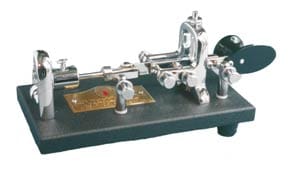
These semi-automatic keys were the first type of automatic key that were used, but today, their mechanical nature and the fact that they can only produce the dots automatically means they are not encountered too often. They are not an option considered by most current day Morse operators, although they are of significant historical interest.
That said, they can still be used with modern or even home built equipment. The only point to watch is that the dot contact is spring loaded and does not always make good contact and often bounces as it makes and breaks contact. This can result in key clicks, especially on home built equipment. Also the contacts can become worn and pitted after use if the current is high.
How to choose the best Morse key
The choice of the best Morse key is often a difficult one. It is often dictated by the anticipated speeds that are likely to be sent, the transmitter to be used, the costs and the preferences of the operator.
There are many Morse keys available from a variety of manufacturers, some of which are much better than others, so it is worth taking a little while to first assess what is needed and secondly which one represents a god buy.
• Selecting a straight key
Often it is best to start with a straight key. This is much easier to control and will be ideal when starting out on the air, although it will limit the speeds that can be sent.
Most amateur radio operators who use Morse will have a straight key - they are an almost essential element of the station, even if more advanced forms of key are normally used.
There is a good variety of Morse keys available - some older keys can be bought from sites like eBay and some of the older keys are well made and they can be bought relatively cheaply. Again, it is worth trying to research what keys are nicer to use before buying.
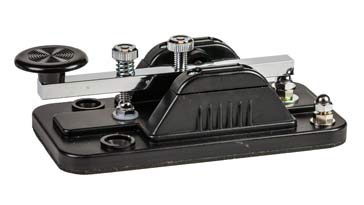
If it is decided to buy a new key, then these can be quite expensive, but buying a good quality key will usually mean that it will be easier to operate. Again, there are many sources online, or via a local amateur radio store.
Again it is worth checking out some reviews before buying.
When looking at the various Morse keys available a few points to note should include:
Pivot freely: In order to enable good Morse code to be sent, any key that might be considered for purchase must be able to pivot freely. Some keys even have a ball-race bearing to ensure free movement.
Spring or tension adjustment: They key should have an adjustment for the tension. Typically this might be adjusted to somewhere in the range of 200 - 400 grams for the force required on the handle. Virtually all keys have an adjustment for this.
Adjustable gap: It is also necessary to have an adjustment for the gap - some people will want a larger gap, and others a smaller one. Having an adjustment for the gap is essential and virtually all keys have an adjustment for this.
No sideways movement in lever: In order to be able to send well, and for the key to make proper contact, the bearings should not allow any sideways movement - only up and down movement. It may be that the bearing can be adjusted as in the case of a steel lever key, but for most other kets it is not possible.
Firm base: A firm base is a major requirement. Many keys have a heavy base as part of the key - sometimes it may be metal, or marble, and others may have a wooden base.
Others may have the facility to be screwed to a table or wooden platform. It is essential that when operating, the key does not move. Having it on a form but moveable base is ideal because it cane be moved to suit the best operating position - if it is screwed down this it won't be easy to move it.
Good feel: It is difficult quantify this, but if a Morse key feels right, then it usually is right. The problem is that often the keys with a better feel, often cost much more.
Other requirements: For some forms of operation, or in other circumstances there are likely to be some special requirements. For example for portable operation size and weight can be an issue. For this type of situation there is a good selection of small keys of all prices. Similarly for requirements, it is possible to look at the best keys to meet these needs.
Typically the top end keys are a delight to use. They have an easy action, they can be adjusted to suit the operator preferences, and they have a firm base with good electrical connections.
If these top end keys are too expensive, then some of the mid-range keys can provide a good option. Although not as luxurious as the top end ones, they still perform well.
If Morse is less frequently used, then the cost of a top end Morse key may not be justifiable. This med range keys are quite satisfactory for many situations and usage..
At the very bottom end of the market, there are some small cheapish plastic keys. While they are still more costly than might be expected, these keys often have little adjustment capability, they are too small for general usage, and they may only have inadequate methods of keeping them in place.
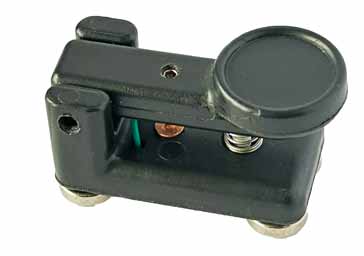
This is an example of a low cost small or midget plastic Morse key. There are soem magnetic screws and some sticky steel washers are provided to try to keep the key in place.
They are not really suitable for home usage where a key is needed - these might just about be suitable for occasional portable usage where the lack of ease of usage might be tolerable, but possibly little else.
Another option that can be considered is to buy a vintage key. There are some very good keys available, and even though they might not be as neat as a bright shiny new key, many of them are very good and can be ideal for many situations. However take some advice from a knowledgeable user or key collector before buying, as it would be very easy to buy one that is not so good.

This is an example of a vintage key dating from around 1900 - it has a good action and it is a delight to use, and definitely one of my favourites..
• Selecting a Morse paddle
For more experienced operators wanting to send Morse code at a faster rate, a Morse paddle is probably the best option.
Most modern ham radio transceivers have connections for a paddle and will be able to generate the Morse from the input from the paddle. Before buying, check that any equipment the paddle will be paired with has the required capabilities. Also check that the transceiver can accommodate operation in both ModeA and Mode B iambic operation if this is important.
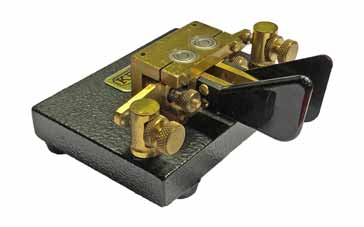
When looking to buy a Morse paddle, there are also points to check about its performance:
One or two paddles: There are two types of paddles that can be used: those with a single paddle or those with two. The single paddle is used so that if it is moved to the right it produces dashes, or to the left then it produces dots.
However there are also twin paddles - these can operate in what is termed iambic mode, or as a "squeeze" keyer. The operation is virtually the same as the single paddle, except that when the paddles are squeezed together then they produce alternate dots and dashes. The starting element, i.e. dot or dash depends upon which paddles was moved first.
Before buying, it's worth checking that any transceiver or other equipment the paddle will be paired with has the required capabilities. It's also worth checking that the transceiver can accommodate operation in both Mode A and Mode B iambic operation if this is important to you.
Pivot freely: As speed is of the essence with a Morse paddles, a good one should have proper bearings to enable the paddle or paddles to move very freely. Good ones have a ball-race bearings to ensure free movement.
Spring or tension adjustment: They key should have an adjustment for the tension. It should be possible to adjust the tens to be what is easy to send Morse over extended periods very easily.
Adjustable gap: It is also necessary to have an adjustment for the gap - some people will want a larger gap, and others a smaller one. Having an adjustment for the gap is essential and virtually all keys have an adjustment for this.
No up and down movement in the paddles: In order to be able to send well, and for the key to make proper contact, the bearings should not allow any unwanted movement - only sideways movement.
Firm base: A firm base is a major requirement. Many keys have a heavy base as part of the key - sometimes it may be metal, or marble. This is aprticaulrly important because it is essential that the overall paddle assembly does not move around the desk when sending.
Good feel: It is difficult quantify this, but if a Morse key feels right, then it usually is right. The problem is that often the keys with a better feel, often cost much more.
Other requirements: For some forms of operation, or in other circumstances there are likely to be some special requirements. For example for portable operation size and weight can be an issue. For this type of situation there is a good selection of small keys of all prices. Similarly for requirements, it is possible to look at the best keys to meet these needs.
There is a variety of different paddle keys available on the market. Good ones are not cheap, but if you are serious about using a paddle key, then it is worth investing in a good one.
There are some very low cost, all plastic ones on the market. These ones have few adjustments, a basic gap adjustment but no real tension adjustment.

These low cost Morse paddle keys are not ideal having little adjustment, a poor "feel" and a far from ideal way of anchoring them to a base or work surface
They also only have magnetic screws in the base to enable them to be held in place in a magnetic surface - two magnetic washers with adhesive are provided for this. However these are far from ideal and do not give the pleasure in operating that a good paddle will provide.
Apart from buying a paddle, an earlier approach was to have a complete keyer as transceivers of the day did not include the required electronics.
It is also possible to buy keyer electronics, and this could be a good option for anyone wanting to use homebuilt or other equipment without Morse keyer capabilities.
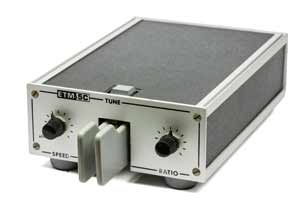
This vintage electronic keyer or El-Bug is quite old now, but still a joy to use and it works very well
These keyers were very popular in the late 1980s onwards when they were often referred to as "El-bugs" or electronic bug keys. The name bug key being one used for the mechanical keyers like the Vibroplex.
Now they are less popular, but they can still be very useful in many instances.
Buying a Morse key can be difficult in view of the number of options available. However if time is spent in determining what is wanted, and then looking at what is available, and if possibly trying some keys or paddles then the right decision can be made.
 Written by Ian Poole .
Written by Ian Poole .
Experienced electronics engineer and author.
More Ham Radio Topics:
What is ham radio
Callsigns
Morse code
Voice modes
Digital data modes
QRP operating
Operating awards
Codes & abbreviations
Ham bands overview
Operating via differnet propagation modes
Repeaters
Callsigns
Contact formats
Setting up a shack & buying equipment
Return to Ham radio menu . . .


